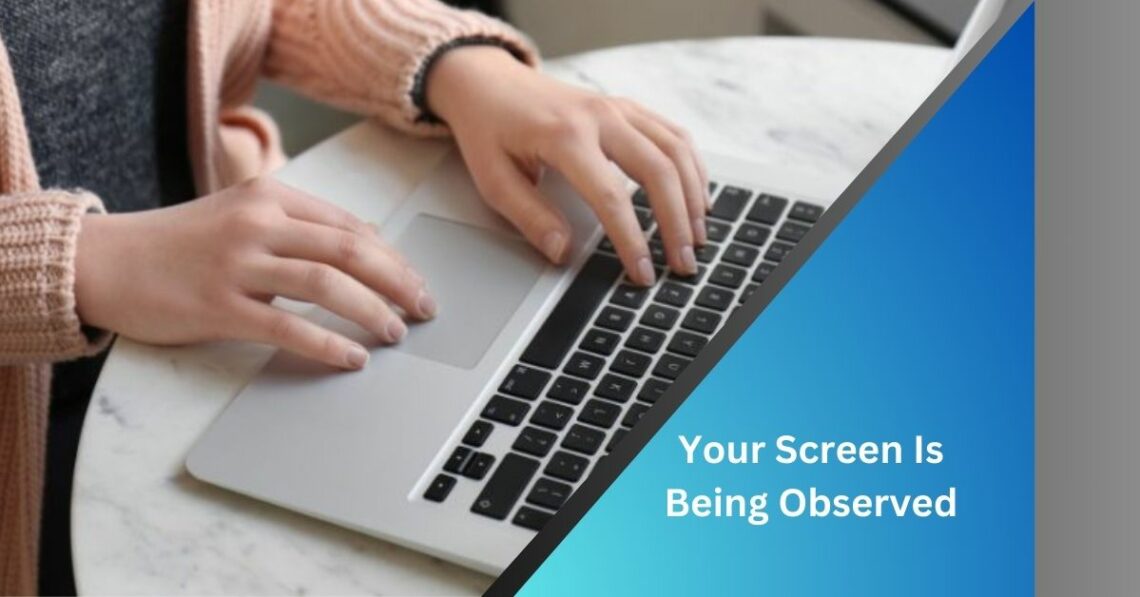
Your Screen Is Being Observed – Click For The Complete Guide!
Privacy has become a paramount concern in the age of technology, where our lives are intricately woven with digital threads. An unsettling reality dawns upon us as we navigate the virtual landscape. Your screen is being observed.
This notification indicates that an app possesses the authority to view the content displayed on your screen and is presently utilizing that permission. It doesn’t necessarily imply active recording of the screen itself.
This article delves into the various aspects of screen observation, shedding light on its reasons, the privacy implications, and how individuals can safeguard their digital space.
Table of Contents
ToggleThe Watchful Eyes – Unlock The Information You Seek!
The digital era has ushered in a new era of connectivity, convenience, and information at our fingertips. However, this convenience comes at a cost – the potential intrusion into our privacy. Various entities, from governments and corporations to hackers and malicious software, have the capabilities for many reasons.

The digital era has indeed revolution revolutionized how information and experience convenience. Our smartphones, tablets, laptops, and other devices have become indispensable tools in navigating the complexities of modern life.
However, this unprecedented convenience is not without its challenges, with one of the most pressing concerns being the potential intrusion into our privacy.
Read Also: WHAT MIGHT BE FOUND OUTSIDE A HIPSTER – LET’S EXPLORE IT!
Reasons Behind Screen Observation – Learn More About It!
Marketing and Personalization:
In the world, businesses once employed sophisticated algorithms to monitor user behaviour. By observing your screen, companies can gather valuable data on your preferences, browsing habits, and shopping history. This data is then used to tailor personalized advertisements and recommendations, creating a targeted and potentially more engaging user experience.

Hackers and Malicious Software:
Entities with nefarious intentions exist in the vast expanse of the internet. Hackers and live malicious software exploit vulnerabilities in security systems to gain unauthorized access to screens.
Whether for financial gain, identity theft, or other malicious purposes, these intruders pose a significant threat to the privacy and security of individuals and organizations alike.
Security Monitoring:
Governments and organizations may engage in screen observation for security purposes. Monitoring employee screens can help detect potential security threats, unauthorized access, or malicious activities within a network. This surveillance is often implemented to safeguard sensitive information and prevent cyber-attacks.
Remote Assistance and Support:
Technical support services often employ screen-sharing tools to assist users remotely. While this is usually done with the user’s consent, it highlights that others can access the four screens for troubleshooting or assistance purposes.

Social media platforms, hubs of personal expression and interaction, are hotspots for screen observation. Companies use algorithms to analyze user engagement, content preferences, and even the emotional tone of posts. While this is primarily for optimizing user experience, it underscores the reality that our online activities are scrutinized closely.
The Pervasive Nature of Connectivity:
The omnipresence of the internet and the increasing interconnectivity of devices have created a seamless web of communication. While this interconnectedness enhances our ability to share information and communicate globally, it also opens avenues for surveillance. Our devices constantly exchange data, creating a digital trail that various entities can monitor.
Read Also: SMART SQUARE THEDACARE – LET’S EXPLORE IN 2024!
Implications for Privacy – Dig Into The Details Here!
Informed Consent:
One of the primary concerns surrounding screen observation is the issue of informed consent. Users are often unaware that their screens are being monitored, leading to a potential breach of privacy. Striking a balance between personalization and user consent is crucial in maintaining ethical digital practices.

Data Security:
The information from screen observation is sensitive and must be handled carefully. In cases where businesses collect user data for marketing purposes, ensuring robust data security measures is essential to prevent unauthorized access and potential data breaches.
User Empowerment:
Empowering users to know how their screens are observed allows them to make informed decisions about their digital interactions. Understanding the extent to which their data is utilized for personalization helps users assert control over their online experiences.
Safeguarding Your Digital Space – Get Informed In a Snap!
Privacy Settings:
Regularly review and adjust privacy settings on your devices and applications. This includes app permissions to access your screen, camera, and other sensitive information. Being mindful of these settings can help you control what data is shared.

Use Virtual Private Networks (VPNs):
Employing a VPN can add an extra layer of security to your online activities by encrypting your internet connection. This makes it more challenging for third parties to monitor your screen or track your online behaviour.
Update Software Regularly:
Keeping your operating system and applications up-to-date is crucial for security. Developers often release updates to patch vulnerabilities that could be exploited by malicious entities aiming to observe your screen without authorization.
Be Cautious with Third-Party Apps:
Exercise caution when granting permissions to third-party applications. Review the terms and conditions and only install applications from trusted sources to minimize the risk of unauthorized screen observation.
Conclusion:
This message suggests that an application has been granted the capability to access the information visible on your screen and is currently exercising that authorization. It doesn’t inherently signify the ongoing recording of the screen per se.
In the ever-evolving landscape of digital interactions, the awareness that your screen is being observed is paramount. Understanding the reasons behind screen observation and its privacy implications and taking proactive measures to safeguard your digital space are crucial steps toward maintaining control over your online presence.
Frequently Asked Questions (FAQs):
1. How can I prevent screen observation on my device?
Ensure your device’s privacy settings are configured appropriately to enhance your privacy and prevent unauthorized screen observation. Use a VPN to encrypt your internet connection and be cautious with third-party apps, granting permissions only to trusted sources.
2. Why do businesses monitor screens for marketing purposes?
Businesses monitor screens to gather data on user behaviour and preferences. This information is personalized with recommendations and recommendations, creating a more targeted and engaging user experience.
3. Is screen observation legal?
The legality of screen observation depends on the context. While employers may monitor employee screens for security reasons, unauthorized and non-consensual screen observation can violate privacy laws. Being aware of and respecting privacy regulations in your jurisdiction is essential.
4. How does screen observation impact data security?
Screen observation involves collecting sensitive information about user behaviour. This data can be vulnerable to unauthorized access and breaches if not handled securely. Implementing robust data security measures is crucial to safeguard against potential threats.
Read Also:
You May Also Like

Cutting-edge Technology: Navigating the Future of Innovation
December 28, 2023
Why Healthcare Organizations Use Technology Consultants for Their Practices
January 24, 2024

